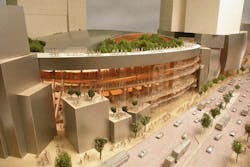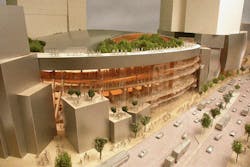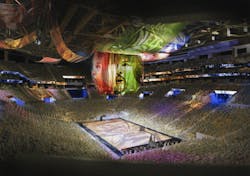Customer Case Study: Forest City Ratner Companies
Forest City Ratner Companies is the Brooklyn, NY-based strategic business unit of Forest City Enterprises, Inc., one of the nation's largest publicly traded commercial real estate development companies (NYSE: FCEA and FCEB).
Real estate development companies that develop, construct and operate a large portfolio of commercial space face significant challenges from an Information Technology (IT) standpoint. This is because, for many companies, the Plan, Build and Operate lifecycle is managed using separate systems for each business segment.
According to Raj Patel, Senior Vice President and Chief Information Officer at FCRC, maintaining multiple systems and platforms is costly and inefficient. What's more alarming, however, is that data integrity is questionable when it's coming from multiple sources, often because of duplicate data entry. Using inconsistent processes and different user interfaces does not allow for the "real-time" data transparency necessary to achieve business intelligence.
In fact, at FCRC, using non-integrated systems created more questions than answers. Paper-based approval processes made it difficult to identify where the bottleneck really was. "We never had complete transparency into our process," says Patel. "Why hasn't this vendor been paid? Why haven't we approved this change? Where does this project cost stand versus the budget? How much did steel cost by retail building for our ownership percentage? These were some of the questions we didn't have answers for and it was even more complicated when we had partners on our projects."
Frustrated with data invisibility, inefficient business processes and the lack of continued R&D in its current software, FCRC decided it was time for a change. As part of a company-wide strategy to reduce the number of one-off systems needed to manage their real estate operations, FCRC chose to replace its current disconnected systems (Sage Software Timberline, Primavera Expedition and a custom reporting tool) with integrated, best-of-breed solutions.
Proliance software from Meridian Systems was selected as the primary replacement. An Infrastructure Lifecycle Management (ILM) solution, Proliance is specifically designed to optimize the Plan, Build and Operate phases of capital construction and facility projects. Proliance would be integrated with the company's new SAP and Open Text Livelink enterprise content management (ECM) software. The end result would be three strategic technology solutions working together as one integrated platform.
Proliance: the Ultimate Tool for Business Intelligence
"Proliance was the first product I came across that matched the FCRC business model," explains Patel. "Managing the whole Plan-Build-Operate lifecycle of an asset is the optimal way for us to do business. Where Timberline or Expedition touched on just one aspect of that cycle, Proliance delivers all three components in one solution. From the day you break ground to the day, decades later, when you sell an asset, Proliance captures all of the data in one system so you have visibility into everything about that property."
After dealing with products that, in his opinion, were not up to par technologically, Patel was impressed that Proliance was developed using the latest Web 2.0 technologies. "As a Microsoft shop, a solution that leverages the Microsoft technologies we already utilize is key," he states. "Having the right philosophy around the Plan-Build-Operate lifecycle of an asset and being built using the latest technology made Proliance the ultimate tool in our toolbox. We now have a tool that captures data about our assets throughout their development lifecycle and gives us the information we need to achieve business intelligence."
Big Benefits
After a year of planning, building and UAT, FCRC anticipates big benefits from Proliance, its integration with Livelink and its anticipated integration with SAP. The replacement of manual paper shuffling with electronic workflow, an audit trail for changes and approvals and transparency into its project portfolio are just some examples. When implementation is complete, Patel anticipates the following results.
Better visibility. "With Proliance, we're able to forecast our costs much more accurately because we have better visibility into a project. We're building $500M shopping centers, $1B skyscrapers and now a $4B arena in Brooklyn. When you consider costs of that magnitude, a small percentage fluctuation amounts to millions of dollars. Proliance gives us visibility into cost versus budget. This allows us to foresee a potential cost overrun well ahead of time and we have the opportunity to realign our anticipated rate of return."
Increased productivity. "Clearly, any time you implement technology like Proliance, your goal is to increase productivity. Double entry will be eliminated. Paper won't be shuffled around anymore. Instead, documents will move from desk to desk electronically in a streamlined fashion. People can view reports right on their desktops and access them as needed. The accounting staff will no longer need to generate a report requested by a developer; the developer can actually get the information directly."
Standardized workflow. "Workflow has been a huge business need at FCRC. Specific to document management in Proliance, we have created a standardized workflow where, using Livelink, we scan invoices, contracts and other documents and route them electronically for approval. All documents reside in the Livelink document management repository that Proliance seamlessly interacts with. This reduces the amount of paper required to support these processes and reduces physical storage costs as well. We also have transparency into where an approval is in the workflow and we can report on where certain things are in their lifecycle. This is a huge benefit."
Improved reporting. "In Proliance, we only need a few key reports with the ability to modify views. The user can drill down to more detail or generate different views of the data to access the business intelligence that's inherent in the reporting component of Proliance. The bottom line is we're getting better information faster."
Decreased risk. "The Proliance system is giving us a complete audit trail of when things were known, exposed, approved and communicated to different parties. Then, with the Livelink integration, we have a repository of every associated document. Changes to project scope, contracts, work authorization approvals - they're all in one spot. Therefore, if we encounter the threat of litigation, we will be able to produce the documents needed to resolve issues in a timely manner.
Solid ROI
When asked about the return on investment (ROI) they expect to see on Proliance, top management has done their homework. "When we talk about developing billions of dollars in real estate," states Patel, "if we can use Proliance to save just a few percentage points through improved decision making, we'll clearly see millions of dollars in return on a single project. Proliance could potentially pay for itself within the first few years of a single, three-to-five-year project."
Atlantic Yards in Brooklyn, New York
Atlantic Yards will be many things to many people. Designed by world-renowned architect Frank Gehry, Atlantic Yards combines a sports and entertainment arena, over 7 acres of landscaped open space, a boutique hotel, ground floor retail space for local businesses, office space and more than 6,470 units of affordable, middle-income and market-rate housing to create a vibrant addition to a thriving borough.
Atlantic Yards will span 22 acres and transform the current railyards and predominantly underutilized industrial area into 17 iconic buildings, including the state-of-the-art arena. The development will produce tremendous economic growth for the borough and city, creating over 15,000 union construction jobs, over 3,800 permanent jobs and generating over $6 billion in net tax revenue over 30 years.
Architect:
Frank Gehry
Key Project Elements
- An 850,000 square foot, state-of-the-art sports and entertainment arena that will be home to the Brooklyn Nets professional basketball team
- 336,000 square feet of office space
- 6.4 million square feet of residential space (6,470 units of affordable, middle-income and market-rate housing)
- 247,000 square feet of retail space
- A 165,000 square foot hotel (180 rooms)
- Over seven acres of intricately designed publicly accessible open space
Estimated Project Cost: $4.2B
Projected Project Completion: 2016
Anticipated Results: Atlantic Yards is one of the most important developments in the history of Brooklyn. It will serve as a proud emblem of Brooklyn's reenergized vitality and create a new home for Brooklyn's very own NBA franchise, the Brooklyn Nets.


